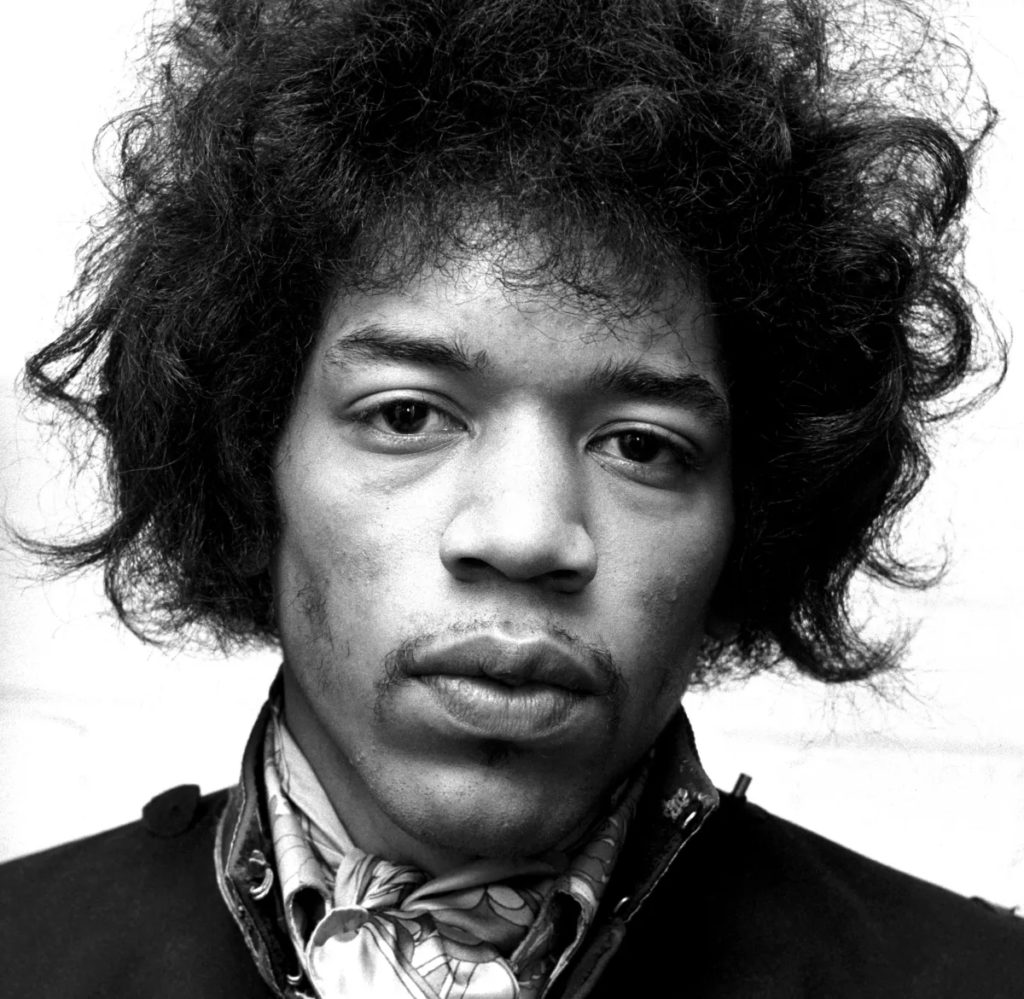
We mark the death on September 18, 1970 – 53 years ago today – of the American guitarist, singer, and songwriter James Marshall “Jimi” Hendrix, at St. Mary Abbots Hospital in London. He was born in Seattle, Washington on November 27, 1942, making him 27 years old at the time of his death, something we will discuss later in this post.
Creating and Mastering a New Idiom
“Top ten” lists are entirely subjective and thus often irrelevant. But they can be informative when they agree and as such, indicate a consensus.
Here are a few such lists of rock ‘n’ roll guitarists, in which I’ve cut to the chase and listed only the “top four.”

Rolling Stone, “100 Greatest [Rock] Guitarists”:
- Jimi Hendrix
- Eric Clapton
- Jimmy Page
- Keith Richards
Writing in Rolling Stone, the American guitarist, singer, songwriter, and political activist Tom Morello explains:
“Jimi Hendrix exploded our idea of what rock music could [italics mine] be. His playing was effortless. There’s not one minute of his recorded career that feels like he’s working hard at it – it feels like it’s all flowing through him. He seamlessly weaves chords and single note runs together and uses chord voicings that don’t appear in any music book. His riffs were a pre-metal funk bulldozer, and his lead lines were an electric LSD trip down to the crossroads, where he pimp-slapped the devil.
His legacy is assured as the greatest guitar player of all time.”
HowStuffWorks, “The Ten Greatest Rock and Roll Guitarists of All Time”:
- Jimi Hendrix
- Jimmy Page
- Eric Clapton
- Stevie Ray Vaughan
Writes Jim Halden of HowStuffWorks:
“Despite all the jockeying for position on this list, there was never any question as to who would end up at the top. In his brief life, Jimi Hendrix forever changed the way people thought about the electric guitar. In his hands, it became more than an instrument; it was a gateway into the soul, a vessel through which to communicate the inner workings of a complex man with immeasurable talent.”
Guitarmetrics, “Top 10 Classic Rock Guitarists”:
- Jimi Hendrix
- SLASH (his real name being Saul Hudson)
- Eric Clapton
- Jimmy Page
Writes the editors of Guitarmetrics:
“The entire landscape of rock music was altered when Jimi first picked up a guitar. He demonstrated to us how to perform feats that were thought to be impossible on a guitar at the time. The guitar itself started to resemble a part of his body.”
I’ll cut to the chase, because with just a couple of exceptions, every “greatest rock guitarist” list I found during a brief but spirited search on the internet put Hendrix at number one, including Guitarist Next Door, Cleveland.com, Music Industry How To, Roadie Tuner, Cultura Sonara, Really Simple Guitar, Louder, Digital Dream Door, Bolly Inside, New Arena, (should I keep going?), The Delite, Music This Day, Rock ‘n’ Roll Remnants, and Skill Share (yes, I’ll stop now).
On those very few lists on which Hendrix wasn’t listed at number one, he was listed at number two, behind either Eric Clapton or Jimmy Page.
Regarding Jimi Hendrix’ place in the pantheon of rock ‘n’ roll guitarists, that’s consensus.
Here’s another bit of consensus. Almost every one of the lists indicated above put Eric Clapton (born 1945) and Jimmy Page (born 1944) in the top five along with Jimi Hendrix.
What makes these three musicians so very special is not just their extraordinary imaginations and technical wizardry; no, something more is involved here. It’s that during the 1960s, they virtually spearheaded the creation of an entirely new instrumental vocabulary, that of the virtuosic, solid body electric rock ‘n’ roll guitar!

Let’s consider this.
The violin family of instruments – the violin, viola, and the cello – were invented in northern Italy in the early 16th century, circa the 1520s. Composers and performers have had 500 years to create a repertoire for these instruments and to progressively develop the technique by which to play them.

As opposed to the solid body electric guitar, which was invented in the early 1940s and came into use in the late 1940s. (For our information, the first mass produced solid body electric guitars were the Fender Esquire and the Fender Broadcaster, which were first produced in 1950.) Whether we credit Leo Fender (born Clarence Leonidas Fender, 1909-1991) or Les Paul (born Lester William Polsfuss, 1915-2009) for its invention is immaterial; by the early 1960s, the solid body electric guitar had become the identifying instrument of rock ‘n’ roll, a genre of dance music that only acquired its name in 1954.…
Continue reading, and listen without interruption, only on Patreon!
Become a Patron!Listen and Subscribe to the Music History Monday Podcast
Podcast: Play in new window
Subscribe: Apple Podcasts | Spotify | Pandora | iHeartRadio | RSS | More
